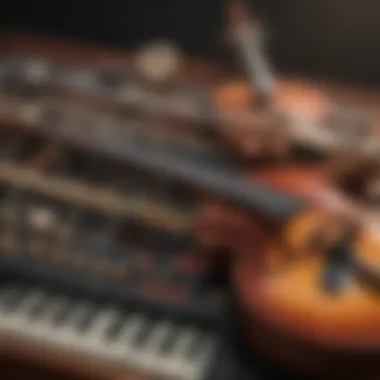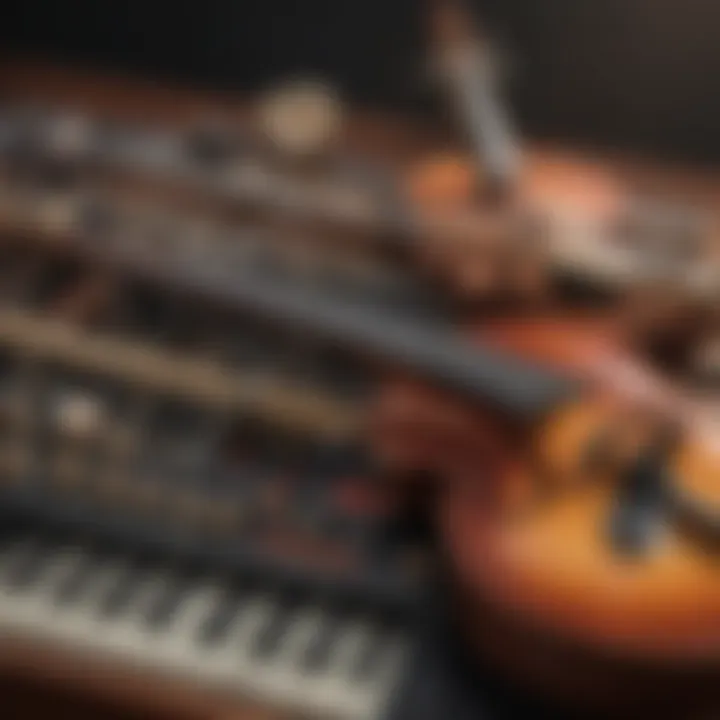Impactful Country Music Songs That Resonate Deeply


Intro
Country music isn’t just a genre; it’s a cultural tapestry, woven together with threads of storytelling, emotion, and vivid imagery. Through countless twists and turns, it has evolved into what we recognize today, encompassing both the traditional classics and the more modern tunes that evoke the same timeless sentiments. Each song tells a story, echoing the experiences of everyday life and conveying the intricate emotions that bind us all together.
The following sections aim to take readers on a journey through some of the most impactful songs in country music. By examining the artists behind these songs, the thematic layers they explore, and the musical craftsmanship that brings them to life, we will delve into the rich landscape of this beloved genre. This exploration is not just for die-hard fans; it serves as a guide for music enthusiasts, aspiring musicians, and students eager to gain a deeper appreciation for the art of country music. The songs we’ll touch upon are like hidden gems, waiting to be discovered beyond the surface of popular charts.
Let’s tune our ears and open our hearts as we embark on this deep dive into the world of country music.
The Foundation of Country Music
The foundation on which country music stands is pivotal, both to its identity and its continual evolution. Understanding these roots not only aids in comprehending contemporary songs, but also reveals how influential historical events and cultural shifts have shaped the genre. At its core, country music is more than just a collection of melodies; it reflects a tapestry of experiences, struggles, and triumphs.
Historical Roots and Evolution
Country music traces its lineage back to a potpourri of American traditions. One can spot its heritage in folk songs sung by early settlers, blending the sounds and stories of different cultures. The late 19th and early 20th centuries saw the emergence of styles like folk, blues, and jazz—this amalgamation played a crucial role in giving country music its distinct voice.
Many artists such as Jimmie Rodgers, dubbed the "Father of Country Music," infused elements of blues into their work, allowing for a new kind of storytelling that mirrored the everyday lives of ordinary people. Similarly, the Carters’ Family, with their blend of traditional folk and the early American church music, helped to solidify the genre's connection to the Southern experience.
As time marched on, the simple acoustic sounds of the past began to adopt new influences. The introduction of electric instruments during the mid-20th century marked a vital shift. Artists like Hank Williams and Johnny Cash ushered in the era of honky-tonk and rockabilly, showcasing the adaptability that remains characteristic of country music today.
Cultural Influences and Regional Variations
Just as a mosaic is crafted from varied pieces, country music is deeply influenced by the cultural nuances and regional styles across the United States. From the Appalachian Mountains to the dusty roads of Texas, each locale adds its own unique twist, enriching the genre's diversity.
The Appalachian influence, known for its fiddle and banjo melodies, evokes a sense of nostalgia for simpler times. Lyrics often convey stories of heartache and resilience, resonating with listeners who appreciate a good tale spun from the tapestry of life.
Conversely, the Nashville sound, which hit its peak in the 1960s, injected a polished production style with a focus on lush backing vocals and orchestration. This was a major departure from traditional sounds and appealed to a broader audience. Songs from this era often touched on themes of love and loss, packaged within catchy hooks that still echo through the airwaves today.
Embedded in country music are also the influences from honky-tonk, which gave rise to a more upbeat and danceable style celebrated in bars and dance halls. The playful nature of honky-tonk can be heard in the works of artists such as George Jones and later, Garth Brooks. The regional variances — from the bluegrass of the Carolinas to the outlaw country of Texas — highlight the rich tapestry of human emotion and experience threaded throughout the genre.
"Country music isn’t just music; it’s a narrative that transcends time and geography, reflecting the pulse of those who live it."
By diving deep into the foundational aspects of country music, we uncover a landscape that is as varied as it is rich with stories. The pivotal historical roots coupled with the geographic influences create a foundation that not only influences modern artists but also keeps listeners engaged, resonating with the essence of what it means to be human.
Defining Characteristics of Country Songs
Understanding the defining characteristics of country songs offers valuable insight into the heart and soul of the genre. Country music isn't just about catchy melodies or simple lyrics; it's a complex tapestry woven from storytelling, emotional depth, and unique sounds. For enthusiasts diving into this world or aspiring musicians looking to refine their craft, grasping these characteristics is essential to appreciate how songs resonate and evoke feelings across diverse audiences.
Lyrical Content and Themes
Lyrical content serves as the backbone of country music, often reflecting the everyday experiences and emotional journeys of ordinary people. The themes explored within the genre range from heartache and love to resilience and celebration. Rather than abstract concepts, country lyrics are grounded in relatable narratives. They tell stories that listeners can see themselves in, like a worn-out pickup truck, the comfort of small towns, or the bittersweet feeling of goodbye.
Key elements to highlight include:
- Storytelling: Many songs craft a vivid narrative, transforming a simple moment into a detailed tale. For instance, think of "The House That Built Me" by Miranda Lambert. In this song, the recollections of childhood and the significance of home take center stage, creating a deep connection with the audience.
- Emotional Expression: The lyrics often explore deep feelings—love, loss, and longing. In tracks like "Whiskey Lullaby" by Brad Paisley and Alison Krauss, the haunting lyrics paint a picture of despair and love lost.
Ultimately, these lyrical attributes not only draw the listener in but also cement the genre's place in cultural discourse, making country music a powerful vehicle for conveying profound emotions.
Instrumentation and Sounds
Instrumentation in country music is distinctive and diverse, playing a vital role in shaping its unique sound. Unlike many other genres that may emphasize electronic production or synthesized instruments, country often leans heavily on traditional instruments that evoke a rustic, timeless feel. Instruments such as the steel guitar, mandolin, banjo, and fiddle are commonly featured, lending an authentic character that audiences have come to associate with the genre.
Important aspects include:
- Acoustic Elements: Many songs prioritize acoustic instruments, creating a warm, inviting sound that resonates with listeners. Think of the soft strumming in Zac Brown Band's "Chicken Fried" or the rich overtones from a well-played banjo in Alison Krauss's tracks.
- Melodic Simplicity: The melodies often remain straightforward yet effective, allowing lyrics and emotions to take the foreground. For example, in Johnny Cash's "Ring of Fire," the simple yet haunting melody complements the profound lyrics about love and heartache.
This blend of traditional instrumentation and melodic simplicity gives country music its unique richness, ensuring it remains both accessible and impactful.
Vocal Styles and Performance Techniques
Vocal expression in country music is another core characteristic that sets it apart from other genres. Vocal styles vary across artists, yet they tend to emphasize clarity, emotion, and storytelling. The authenticity of the voice becomes a crucial vessel for conveying the song's narrative.
Elements worth noting include:
- Techniques: Many artists utilize traditional vocal techniques, like twang, which enhances the emotional delivery of lyrics. This can be heard in artists like Dolly Parton and her distinctive sound that transports listeners straight to the heart of a story.
- Dynamic Range: Performers often showcase a wide dynamic range, allowing for contrasting moments of soft, heartfelt expression and powerful belting. This is evident in songs like Carrie Underwood's "Before He Cheats," where she combines anger and heartbreak into her vocal performance effectively.
By emphasizing these vocal styles and techniques, country artists create performances that not only entertain but also connect deeply with listeners.
“Country music is built on storytelling that stirs the heart and mirrors life’s many shades.”


Influential Country Artists and Their Signature Songs
Exploring the landscape of country music wouldn’t be complete without taking a close look at the artists who have left an indelible mark on the genre. These influential figures not only helped shape the sonic palette of country music but also created songs that resonate deeply with listeners. Each artist brings their own flavor to the table, drawing from personal experiences and cultural backgrounds.
Legacy of Classic Artists
The classic era of country music gave birth to several legendary artists whose songs continue to be celebrated. Names like Johnny Cash, Dolly Parton, and Hank Williams are synonymous with the genre's rich history.
Johnny Cash, with his deep baritone voice, transformed the narrative style of country music. His signature song "Ring of Fire" blends a poignant story with a memorable melody. He tackled themes of love, despair, and redemption, offering listeners a glimpse into his soul. Through his music, Cash ushered in a wave of authenticity that many still strive to emulate today.
Dolly Parton’s impact cannot be overstated. Her songwriting prowess is remarkable, with songs like "Jolene" showcasing her ability to craft relatable and vivid narratives. Parton’s unique ability to weave a compelling story with emotional depth has profoundly influenced aspiring musicians.
Hank Williams is known for his heart-wrenching lyrics and memorable melodies. Songs like "Your Cheatin' Heart" became cultural touchstones, highlighting the struggles of everyday life. His work established a standard that continues to inspire countless artists in the genre.
Contemporary Voices in Country Music
As the genre evolved, contemporary artists began to redefine what country music could be. Names such as Miranda Lambert, Kacey Musgraves, and Chris Stapleton emerged, each contributing their distinct sound and sensibilities.
Miranda Lambert is known for her fierce independence and storytelling capabilities. Her song "The House That Built Me" resonates powerfully, revealing profound connections to personal and familial roots. Lambert’s ability to express vulnerability while maintaining strength speaks to a modern generation of country fans.
Kacey Musgraves, with her blend of traditional and contemporary sounds, is another artist challenging the norms. Her critically acclaimed album, Golden Hour, features tracks like "Butterflies," which explore themes of love and self-discovery in refreshing ways. Musgraves’ unique voice and perspective are crucial in reflecting today's diverse landscape of country music.
Chris Stapleton, recognized for his soulful voice and bluesy sound, has become a beacon for authenticity in recent years. "Tennessee Whiskey" is a cover that brought him national acclaim, but it's his original works that truly highlight his incredible songwriting skills. Stapleton's music often draws from deep personal experiences, creating a raw emotional connection with listeners.
Emerging Talents Shaping the Future
Even as legacy artists and contemporary figures continue to thrive, a new wave of talent is rising through the ranks. Names like Tyler Childers, Margo Price, and Breland are making waves and infusing fresh energy into the genre.
Tyler Childers, with his blend of country and Americana, tells stories that resonate with a younger audience. His song "Feathered Indians" encapsulates rural life and the struggles of love, connecting with listeners on multiple levels. Childers represents a movement that marries traditional sounds with modern-day themes.
Margo Price is another artist at the forefront of this movement. Her debut album, Midwest Farmer’s Daughter, drew critical acclaim for its unflinching honesty and vivid storytelling. With tracks like "Hurtin' (On the Bowery)," Price captures real-life struggles while embracing the complexities of womanhood within the genre, signifying a progressive step forward.
Breland is breaking the mold with his genre-blending sound that incorporates elements of hip-hop and R&B into country music. His hit song "My Truck" demonstrates a refreshing take on what country can represent today. Emerging talents like him reflect the changing landscape, pushing the boundaries of traditional country music.
The next generation of country artists is not just preserving the traditions of the genre; they are boldly redefining it, ensuring that country music continues to evolve and resonate with new audiences.
As we delve into the world of country music, it’s evident that influential artists, be they from our past or present, play a crucial role in shaping the narrative of the genre. Each song they create embodies the struggles, joys, and stories of society, making this musical journey an indelible part of our cultural fabric.
Analysis of Iconic Country Songs
The realm of country music is rich with stories, sentiments, and reflections of the human experience. The analysis of iconic country songs not only enhances our understanding of this genre but also reveals the intricate layers that make these compositions resonate deeply with audiences. The importance of this analysis lies in unpacking the expertly crafted narratives, the emotional undercurrents in the lyrics, and the production elements that together create an unforgettable auditory experience.
By examining these songs, listeners can appreciate the artistry involved in songwriting and the connections forged between the artist and their audience. It invites music enthusiasts to explore the rich tapestry of cultural contexts and personal experiences embedded in the music. This process helps aspiring musicians and students recognize the techniques that lead to impactful songwriting, ultimately shaping the future of the genre.
The Storytelling Tradition
At the heart of country music lies a profound storytelling tradition. Each song often serves as a diary entry, reflecting personal experiences or broader social themes. For example, Johnny Cash's "A Boy Named Sue" tells a vivid tale of a troubled relationship between a father and son. The narrative is not only engaging but also evokes empathy, drawing listeners into the emotional landscape of the characters involved.
In many cases, the storytelling aspect of country music uses familiar motifs like loss, love, and redemption, painting a relatable picture for audiences. Each song unfolds like a short film, engaging listeners and often inviting them to reflect on their own life experiences. Thus, the storytelling tradition in country music endows the genre with an incredible depth—far beyond mere entertainment.
Emotional Resonance in Lyrics
The lyrics in country music carry significant emotional weight, tapping into universal themes that cross generational boundaries. Artists like Dolly Parton and Willie Nelson masterfully weave sentiments of heartache, yearning, and hope into their lyrics. Take, for instance, Parton's "Jolene," where the desperation and vulnerability are palpable through every line—"And I had to have this talk with you, My happiness depends on you."
This emotional resonance is achieved usually through a combination of poetic language and honest expressions. Listeners are often left with a lingering sense of connection, many finding solace in the vulnerability these songs convey. This generates a sense of community among fans, where shared interests lead to deep emotional bonds, even if the experiences reflected in the lyrics differ across individuals.
The Role of Production Techniques
Production techniques play an essential role in shaping the sound and feel of iconic country songs. The choice of instruments, arrangements, and recording techniques contribute significantly to the overall impact of the music. Instruments such as the steel guitar, banjo, and fiddle are often used to evoke specific atmospheres that align with the song's narrative.
Additionally, the layering of sounds and harmonies can amplify the emotional tone of the lyrics. For instance, the engaging production of Kacey Musgraves' "Space Cowboy" uses subtle harmonies and a soft instrumental backdrop to create a feeling of wistfulness. The way her voice weaves through the instrumentation is a testament to how production can elevate the storytelling experience.
In summary, the blending of lyrics, storytelling, and production techniques culminates in the creation of songs that resonate deeply within the hearts of listeners. Through this analysis, we uncover not just what makes a song a favorite but also the craftsmanship behind it. Understanding these elements fosters better appreciation and encourages exploration within this vibrant genre.
Cultural Significance of Country Music
Country music is not merely a genre; it serves as a mirror reflecting the complexities of American culture. This art form, deeply rooted in historical contexts and social narratives, resonates on multiple levels with audiences. Its significance stretches beyond melodies and rhythms; it embodies storytelling traditions and voices of communities, providing insights into prevailing societal issues.
Music has long been a vehicle for self-expression and cultural commentary. Country music, in particular, holds a unique space in this landscape by offering a platform that speaks to experiences of a wide demographic. Whether it’s joy, heartache, resilience, or social commentary, country songs manage to capture the essence of the human spirit, often addressing themes that are universally relatable. The multilayered narratives in its lyrics engage listeners and provoke thought, allowing them to reflect on not only their own lives but also broader social conditions.
Reflections of Social Issues


Through the lens of its lyrics, country music frequently addresses social concerns that range from rural poverty to family struggles and personal heartbreak. These topics are not only evident in the songs themselves but also help pave the way for urgent discussions about societal dynamics. For example, an artist like Kacey Musgraves, in her song "Follow Your Arrow," explores concepts of acceptance and authenticity, challenging traditional norms within communities.
The genre has seen a transformation over decades, adjusting to reflect the evolving landscapes of American life. Historical songs like "The Great Dust Storm" chronicle the struggles during the Great Depression, while modern compositions might incorporate themes of immigration or mental health. This evolution underlines how country music evolves alongside societal transformations, making it relevant through the ages.
"Country music is a reflection of the soul of America—a testament to joy, grief, and everything in between."
Country Music as a Cultural Touchstone
Country music serves as a cultural touchstone, weaving itself into the fabric of social events, traditions, and even personal identities. The genre's roots in rural communities foster a sense of belonging and community, connecting individuals through shared experiences. From honky-tonks to county fairs, live music events are steeped in tradition, celebrating not just a music genre but a way of life.
This connection is palpable during communal gatherings, where songs are sung that have become anthems of generations. Artists like Willie Nelson and Dolly Parton, with their timeless hits, transcend age and region, offering songs that instantly evoke nostalgia and camaraderie. Their music encapsulates sentiments of longing and love, and this sense of familiarity helps form emotional bonds among listeners.
Moreover, social media platforms like Facebook and Reddit have also played a significant role in promoting country music. With the rise of these sites, fans can share their stories, favorite songs, and beloved artists, thus fostering a digital community around the genre while amplifying its cultural significance.
As country music evolves, its ties to social issues and collective memories remind us of the power it holds in shaping conversations, preserving histories, and influencing cultural identities.
The Intersection of Country with Other Genres
Country music has always been a melting pot of various musical styles, contributing to its rich tapestry and widespread appeal. By intertwining elements from other genres, country music not only expanded its horizons but also carved out new pathways for artistic expression. This intersection is significant as it captivates a broader audience and reflects the evolving nature of musical landscapes. The blending of genres has consequences beyond mere sonics; it has shaped the very identity of country music, inviting diverse influences and narratives into what many see as an expression of culture and emotion.
Country Pop and Its Popularity
When discussing the crossover appeal of country music, one cannot overlook the genre of country pop. Characterized by catchy melodies and polished production, country pop has taken the musical world by storm. Artists like Taylor Swift and Kacey Musgraves have seamlessly blended pop sensibilities with country storytelling, drawing in listeners from outside the traditional country sphere.
This popularity hasn't emerged from thin air; it reflects shifts in listener preferences. As audiences gravitate toward more accessible and radio-friendly music, country pop has risen to the occasion, often dominating the charts. Moreover, this subgenre has helped to bridge gaps between disparate musical communities, encouraging collaborations that were once thought impossible.
Rock Influences in Country Music
Rock music has made a substantial imprint on country, serving as a source of inspiration for several artists. The fusion of rock and country can be traced back to legends like Johnny Cash and Waylon Jennings, who incorporated elements of rockabilly and folk into their sounds.
In recent years, this trend has only intensified. Modern artists such as Eric Church and Miranda Lambert often infuse rock guitar riffs and rhythms, creating an energizing experience for their audience. This fusion not only broadens the scope of country music but also reflects a willingness among artists to explore new sounds, resulting in songs that resonate deeply with diverse audiences.
Folk and Bluegrass Roots
Digging deeper into country music’s foundation, we find the undeniable influence of folk and bluegrass. These roots are evident in the storytelling tradition that permeates country music, where lyrics often weave tales of everyday life, love, and struggle. Folk’s emphasis on acoustic instruments and narrative-driven lyrics laid the groundwork for what would become country music. Artists like Alison Krauss exemplify this connection, often incorporating bluegrass elements into their works, displaying the intricate harmonies and instrumentation that define the subgenre.
The continuation of these styles shows that even in an evolving landscape, the influence of folk and bluegrass remains strong, grounding country music in a history that values artistic sincerity and genuine expression.
The cross-pollination of genres not only enriches country music but also energizes the entire music industry, allowing for creative innovation and the birth of new styles.
Exploring Subgenres within Country Music
Delving into the subgenres of country music offers a glimpse into the diverse sounds, styles, and narratives that have shaped this genre over the decades. Each subgenre carries its unique flavor, reflecting cultural shifts, regional diversities, and the ever-evolving landscape of musical tastes. By understanding these distinctions, listeners can appreciate the richness of country music, uncover hidden gems, and even find personal connections to particular styles. Examining subgenres also highlights the genre's adaptability, allowing it to resonate with different audiences while maintaining its roots.
Bluegrass and Its Heritage
Bluegrass music stands as a cornerstone of country music, embodying a rich heritage that can be traced back to Appalachian folk traditions. With its syncopated rhythms and high-energy instrumentation, bluegrass showcases instruments like the banjo, fiddle, and mandolin. This genre isn't just about sound; it tells a story of community, resilience, and the struggles of everyday life.
Key Features:
- Instrumentation: Characterized by the twang of the banjo and the sweet sound of the fiddle.
- Vocal Harmonies: Tight vocal harmonies reflect a deep connection among performers.
- Storytelling: Often revolves around themes of love, loss, and the human experience.
Bluegrass emphasizes improvisation, allowing musicians to showcase their skills. The genre's influence can be seen in contemporary country, with artists incorporating bluegrass elements to add depth to their sound.
Modern Country and its Evolution
Modern country music has come a long way from its traditional roots. As societal tastes shifted, so too did the sound of country, blending elements from pop, rock, and even hip-hop. This evolution reflects not only the genre's adaptability but also its acceptance of a broader spectrum of influences.
Notable Trends:
- Cross-Genre Collaborations: Artists frequently team up with musicians from different genres, expanding their reach.
- Pop Influences: Catchy hooks and polished production have become a hallmark, appealing to a wider audience.
- Diverse Topics: Modern country songs tackle a variety of themes, from partying to personal struggles, making it relatable for many.
Artists like Kacey Musgraves and Luke Bryan exemplify this movement, utilizing contemporary sounds while still honoring country traditions. The ongoing dialogues between traditional and modern elements keep the genre fresh and relevant, attracting listeners from all walks of life.
Outlaw Country: A Defiant Voice
Outlaw country emerged in the late 1960s as a counterpoint to the polished sounds of mainstream Nashville. Artists sought to break away from commercial constraints, often embracing a rougher, more authentic style that spoke to personal truths and socio-political realities.
Characteristics:
- Raw Sound: The music features gritty instrumentation and honest, unrefined vocals, emphasizing individuality.
- Lyricism: Lyrics often reflect real-life experiences, addressing themes of rebellion, heartache, and societal issues.
- Cultural Identity: Outlaw country fosters a sense of belonging for those who feel marginalized by the mainstream successes of more traditional acts.


Icons like Willie Nelson and Johnny Cash have left a lasting legacy that continues to influence artists today, encouraging them to express their authentic selves and challenge the status quo. Outlaw country reminds us that music is not only a form of entertainment but also a powerful means of expression and defiance.
Outlaw country may have begun as a rebellion, but it now serves as a critical voice for many, echoing the sentiments of those who feel unheard.
Music Videos and Their Impact on Country Songs
In today's digital age, music videos play a pivotal role in shaping the perception and popularity of country songs. They act as a catalyst for storytelling, often transforming the auditory experience of a song into a visual spectacle that resonates with audiences. The marriage of visuals and audio can magnify the thematic elements present in the lyrics, allowing viewers to connect with the narratives on a deeper level.
Music videos provide an opportunity for artists to visually interpret their songs, creating a vivid context that can appeal to a broader audience. This visual storytelling not only enhances the song's meaning but also contributes to its emotional impact. A well-crafted video can elevate a song from being just a track on a playlist to a compelling narrative that people want to talk about and share. Moreover, when considering the competitive nature of the music industry, an engaging music video can serve as a powerful marketing tool, helping songs cut through the noise.
Visual Storytelling Techniques
Visual storytelling in country music videos often employs a mix of relatable scenarios and emotional arcs that echo the song's themes. Artists like Carrie Underwood have perfected this technique, using dramatic narratives that emphasize the heartfelt emotions embedded within their songs. For example, her video for "Before He Cheats" tells the tale of betrayal and revenge through powerful imagery that resonates with listeners' experiences.
A few common visual storytelling techniques used in these videos include:
- Character Development: Creating relatable characters that embody the song's narrative.
- Setting: Utilizing rural and Americana aesthetics to evoke feelings of nostalgia and familiarity.
- Symbolism: Implementing symbols that reinforce the themes explored in the song. For instance, a broken pickup truck may symbolize lost love or hardship.
By weaving these techniques together, artists can create a cohesive story that not only entertains but also elicits emotional responses from viewers, solidifying the song's impact.
The Role of Imagery and Symbolism
Imagery and symbolism in music videos are essential tools that contribute to the audience’s understanding of the song's message. These elements can signify deeper meanings, resonate with cultural motifs, or even reflect personal stories. For example, in the music video for "Humble and Kind" by Tim McGraw, we see simple but poignant images of everyday life that align with the song's moral lessons. This imagery encourages viewers to reflect on their values and behavior, making the song's message more impactful.
Imagery can also serve to contextualize a song within a particular cultural or social framework. Notably, the use of rural landscapes and traditional symbols in country music videos can evoke a sense of home and heritage, allowing listeners to connect with the artists on a cultural level.
"Songs that resonate often have visuals to accompany them that deepen our connection to the music and broaden our understanding of the themes they convey."
Furthermore, the use of color, lighting, and even costume choices within the video can influence how a song is perceived. A dark, moody aesthetic can enhance themes of heartache, while bright, vibrant visuals can amplify feelings of joy and celebration.
In summation, music videos serve as a significant aspect of country songs, employing visual storytelling techniques and rich imagery to elevate the narrative of the music. As the industry evolves, the impact of these visual elements will likely continue to grow, making music videos an integral part of how country songs resonate with listeners.
The Future of Country Music
As we glance towards the horizon of country music, two main aspects need careful consideration: the evolution of trends in the genre and the influence of technology on music production. The future of country music does not just lie in preserving its rich history, but also in expanding its boundaries, embracing diverse genres, and adapting to the changing landscape of music consumption. The landscape is always shifting, and it’s vital to explore what may lie ahead for this enduring genre.
Trends Shaping the Genre
As country music continues to evolve, certain trends have come to prominence, reflecting broader shifts in society and culture. Here are some noteworthy developments:
- Cross-Genre Collaborations: The blending of styles, such as country with hip-hop or pop, is increasingly common. Songs like "Old Town Road" by Lil Nas X exemplify how these collaborations can break traditional barriers, capturing audiences who may not usually gravitate toward country.
- Diversity and Inclusion: There's a growing focus on promoting artists from diverse backgrounds. Musicians like Mickey Guyton and Jimmie Allen are gaining recognition, inviting fresh perspectives and broadening the narrative scope of country music.
- Resurgence of Storytelling: While storytelling has always been a cornerstone of country music, there’s a resurgence in crafting narrative-driven songs that tackle modern themes. This trend resonates with listeners looking for authenticity and connection.
"Country music can serve as a refined lens through which we view society's issues; it reflects what’s happening at the moment while honoring the tradition of storytelling."
- Emphasis on Mental Health: An emerging theme in country music is the focus on mental health and emotional wellness, making the genre more relatable. Artists are increasingly addressing vulnerability, showcasing their personal stories in their lyrics.
These trends are more than mere fads; they signify a transformative period in country music that can open doors for deeper engagement with both new and established audiences.
The Role of Technology in Music Production
Technology has forever altered the way music is created, distributed, and experienced. In country music, these advancements provide numerous advantages:
- Home Recording Software: Tools like GarageBand or Pro Tools allow aspiring musicians to produce high-quality tracks from their own homes. This democratization means that more voices can enter the genre, enriching its landscape.
- Streaming Services: Platforms like Spotify and Apple Music have revolutionized music consumption, influencing not just how fans listen but also how artists market themselves. New artists can leverage playlists to gain visibility, often leading to increased concert bookings and fan engagement.
- Social Media Presence: Social media plays a crucial role in an artist's career. Country musicians utilize platforms like TikTok and Instagram to share snippets of their work, build their brand, and connect with fans on a personal level. This instantaneous feedback loop shapes their music and performance strategies in real-time.
- Digital Promotion: Utilizing algorithms for targeted advertising allows artists to reach specific demographics interested in their style of music. This can yield a more engaged fanbase and increase interactions, leading to potential live audiences at performances.
In summary, the future of country music is characterized by the blending of tradition and innovation. As new trends emerge and technology evolves, the genre will continue to transform, creating rich and varied expressions that capture the essence of modern life while honoring its roots.
Ending: Understanding Country Music's Legacy
As we tie together the threads of the narrative woven through this exploration of country music, it’s essential to reflect on the profound legacy this genre bestows upon music and culture at large. Country music is not just a classification of sound; it embodies a rich history that mirrors the trials and triumphs of the human experience. The songs discussed throughout this article act as both a reflection of societal norms and an intimate look into the lives of those who create and consume them.
The importance of the conclusion lies in recognizing that country music serves as a cultural touchstone for millions. Its storytelling tradition resonates on an emotional level, giving voice to the struggles, joys, and everyday experiences of people. Each song encapsulates moments in time, painting vivid pictures of love, loss, heartache, and resilience. With the integration of varying regional influences and personal styles, country music adapts to contemporary issues while remaining rooted in its historical origins.
Furthermore, country music fosters a sense of community, unifying listeners through shared experiences and narratives. From downtown honky-tonks to large-scale music festivals, these songs cultivate connections among diverse groups of people. The genre is constantly evolving, but its core remains the same: a heartfelt commitment to authenticity and emotional honesty.
"Country music reaches the soul in ways that few other genres can—its stories are our stories, and its melodies linger long after the last note is played."
In this respect, the legacy of country music extends beyond merely entertainment. It challenges artists and listeners alike to confront their own realities, offering pathways for understanding and dialogue. Just as the genre has thrived through the influences of blues, folk, and rock, its future will undoubtedly be shaped by new artists who infuse modernity with tradition.
As we look ahead, the continued exploration of country music is not merely an academic exercise but a celebration of its ever-evolving landscape. For music enthusiasts, aspiring musicians, and scholars, understanding the legacy of country music is to grasp a piece of the American narrative while contributing to its ongoing story. This journey deepens our appreciation for the genre, urging us to delve into the rich tapestries of sound that throughout the ages have defined and redefined what country music truly represents.
Summation of Key Insights
In summation, the resonance of country music lies in its capacity to blend personal experiences with universal themes. Here are a few key insights from our exploration:
- Cultural Reflections: Country music acts as a mirror, reflecting both personal and societal values, as seen in its lyrical content.
- Emotional Connection: The storytelling aspect evokes deep emotions, making listeners feel intimately connected to the narrative shared in each song.
- Diverse Influences: While deeply rooted in tradition, the genre embraces influences from various musical styles, enriching its sound.
- Community and Identity: Country music cultivates a sense of belonging, uniting fans and artists alike under a shared cultural identity.
As country music continues to evolve, understanding its legacy becomes paramount for appreciating its nuances and contributions to the broader musical landscape.







